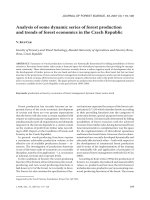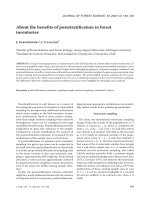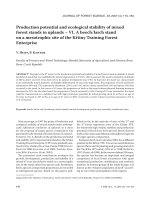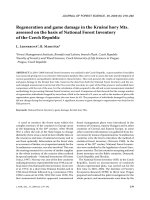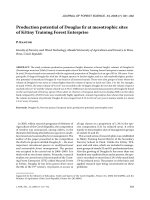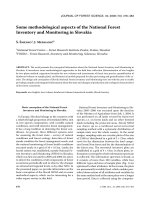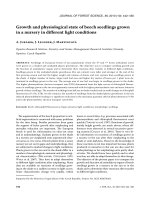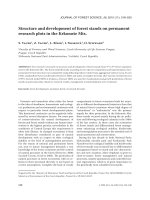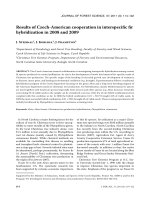Báo cáo lâm nghiệp: "Production and humus form development in forest stands established on agricultural lands – Kostelec nad Černými lesy region" potx
Bạn đang xem bản rút gọn của tài liệu. Xem và tải ngay bản đầy đủ của tài liệu tại đây (188.89 KB, 7 trang )
J. FOR. SCI., 55, 2009 (7): 299–305 299
JOURNAL OF FOREST SCIENCE, 55, 2009 (7): 299–305
Afforestation and reforestation of agricultural land
were a common feature in different historical periods
in the Czech lands, they were carried out under the
most diversified site as well as socio-economical
conditions. Besides the marginal mountain and pied-
mont lands, the abandoned areas were also reforest-
ed at the middle and lower altitudes (K 1976).
e experimental plantations as well as the practical
and commercial ones were established in the whole
Czech Republic including neighbouring countries
(S, L 2006; Š 2006; H-
et al. 2006). e aim of these activities was
to increase forest cover in the landscape, sometimes
fulfilling special functions such as windbreaks,
bio-corridors (T 2006), but the most common
expected function was production and stabilization
of the lands. ere are more publications available
as for the growth and other tree species aspects on
the former agricultural lands. What has been miss-
ing up to now, it is the quantification of the effects of
new stands on the soil, on the restoration of its forest
character – with some exceptions from the last time
(H-T et al. 2004; K et al. 2006;
N, S 2006; N et al. 2007).
e aim of the paper is to increase the knowledge
concerning the afforestation effects at the middle
and lower altitudes, particularly in the territory
of the Training Forest Enterprise in Kostelec nad
Supported by the Ministry of Agriculture of the Czech Republic, Research Project No. QG 50105.
Production and humus form development in forest stands
established on agricultural lands – Kostelec nad Černými
lesy region
V. P
1
, J. R
1
, V. H
1
, W. K M
2
1
Faculty of Forestry and Wood Sciences, Czech University of Life Sciences in Prague,
Prague, Czech Republic
2
USDA, Forest Service, Northern Research Station, St. Paul, U.S.A.
ABSTRACT: e afforestation of agricultural lands was carried out under different site and ecological conditions,
including lower and medium elevated localities. e present study documents the rapidity of accumulation of surface
layers and their characteristics in stands of Scots pine (Pinus sylvestris), Norway spruce (Picea abies), birch (Betula
verrucosa) and Douglas fir (Pseudotsuga menziesii) in the territory of the Training Forest Enterprise in Kostelec nad
Černými lesy, at the altitude 430 m a.s.l., on the site of nutrient-poor gleyed soils. e plots were compared with the
neighbouring continuously forested site covered with old pine-spruce stand and with near-situated arable field. During
the first roughly 40 years, considerable changes were documented on the afforested plots. Forest-floor humus layers in
the coniferous stands have already been formed, the humus forms being more favourable compared with the old forest
site. Acidification and loss of nutrients run in the upper mineral horizons. ese processes were also responsible for the
less favourable character of the forest soil in the old stand. Birch showed minor shifts of soil properties in the mineral
horizon compared to the conifers; the surface humus accumulation was not observed there yet. e lowest degradation
among conifers was shown in Douglas fir, intensively taking up deficient nutrients on the other hand.
Keywords: afforestation; agricultural lands; tree species; forest-floor humus; soil characteristics
300 J. FOR. SCI., 55, 2009 (7): 299–305
Černými lesy, so the comparison with results of
other site conditions. To this moment, the authors’
team evaluated the tree species effects on the humus
form establishing in the area of Český Rudolec (P-
, Š 2002), at the higher altitudes
of the Krušné hory Mts. (P et al. 2006),
possibly in combination with different thinning
regimes (P 2006). is paper documents
the effects of particular tree species (Norway spruce
– Picea abies, Scots pine – Pinus sylvestris, birch
– Betula verrucosa and Douglas fir – Pseudotsuga
menziesii) on soil properties on the reforested ag-
ricultural land and compares their status with the
soils of neighbouring forest stands at permanently
forested localities as well as with arable soil.
MATERIAL AND METHODS
Experimental plots were established in the ter-
ritory of the Training Forest Enterprise, close to
Krymlov village within the Kostelec Forest District.
All plots were established by planting in 1967. e
altitude of the study locality is ca 430 m a.s.l., mean
annual precipitation is 600 mm, and mean annual
temperature is 7.5°C. e forest site was classified
as 4Q (nutrient-poor gleyic soil; fir with oak natural
species composition). e study was performed in
the stands of four tree species on afforested agricul-
tural lands, in a neighbouring forest stand on con-
tinuously forested land (mixed Scots pine – Norway
spruce stand) and in a near field – arable soil.
e first plot was established in the stand of Scots
pine (Pinus sylvestris), the plot area is 0.25 ha. e
total stand area is 2.50 ha.
e second plot is located in the stand of Norway
spruce (Picea abies) of total area 3.98 ha, the plot
area is 0.191 ha.
e third plot is situated in the birch stand (Betula
verrucosa) of total area 0.7 ha, the measured area is
0.134 ha. e last plot encloses the stand of Douglas
fir (Pseudotsuga menziesii), the whole stand was
included (0.125 ha – Table 1). For comparison, the
neighbouring areas were included – mature pine-
spruce stand on forest land and arable land – raps
field. No stable plots were established here.
e plots on former agricultural land were de-
limited and their plot was quantified. e trees were
pruned (dead branches) to the height enabling free
access to measurements: indexing, registration, dbh
measurement. e diameters were determined with
callipers within 1 cm intervals. Two cross-measure-
ments were done; 4 cm diameter classes were used.
e height was measured in two trees from each
tree class (Field-Map technology). dbh and height
measurements were used for the volume calculations
using Volume Tables (LESPROJEKT 1952).
Soils, i.e. holorganic layers and the uppermost part
of the mineral soil body (Ah horizons), were sampled
in October 2006. In the coniferous stands, the forest-
floor layers were sampled using the iron frame 25 by
25 cm. In the birch stand and on the arable soil, the
surface humus was not present. e samples were
taken from the depths 0–10 and 10–20 cm. e min-
eral soil horizons were not sampled quantitatively.
e analyses of individual samples were performed.
Number of replications was 4 in all plots.
ese characteristics were determined:
– amount of dry matter (D.M.) of holorganic hori
-
zons at 105°C and calculation per 1 ha area,
– total carbon content (humus content) using the
Springel-Klee method, total nitrogen content us-
ing the Kjeldahl method,
– soil reaction (pH) in water and 1 N KCl, potentio-
metrically,
Table 1. Comparison of the production potential of particular tree species in stands established on former agricultural
land
Species Scots pine Norway spruce Birch Douglas fir
Plot (ha) 0.25 0.191 0.134 0.125
Age 39 39 39 39
N (trees) 352 221 59 116
Trees/ha 1,408 1,157 440 928
Mean height (m) 20.6 20.1 24.0 21.6
Mean diameter (cm) 19.5 19,5 21.4 23.8
Volume/plot (m
3
) 88.2 66.7 21.1 54.6
V (m
3
/ha) 352.1 349.4 157.1 438.6
J. FOR. SCI., 55, 2009 (7): 299–305 301
– characteristics of the soil adsorption complex ac-
cording to the Kappen method: S – base content,
T-S (H) – hydrolytical acidity, T – cation exchange
capacity, V – base saturation,
– plant available nutrients using the Mehlich III
solution. e P-content was determined spectro-
photometrically, the other nutrients by AAS,
– characteristics of the exchangeable acidity in the
KCl solution,
– total nutrient content in the holorganic horizons,
after mineralization by the mixture of sulphuric
acid and selenium. e analyses were done by the
Tomáš Laboratory in Opočno. Only a limited set
of the most indicative results is documented in the
present paper.
e statistical evaluation was performed using
the statistical software S-PLUS by the analysis of
variance method. The results were evaluated by
Scheffe’s method by multiple comparisons on the
95% significance level. e horizons of the same type
were compared.
RESULTS AND DISCUSSION
a) Stand volume
Particular tree species showed largely differen-
tiated growing potentials. Table 1 documents the
results of dendrometric measurements in a com-
prehensive form. The pine stand has the highest
density, the birch one the lowest. Birch reached the
maximum height, but its stand was very sparse to
show a large standing volume. Douglas fir showed
the second height, which together with maximum
dbh and relatively high density resulted in the
largest standing volume. The highest production
and relatively high density were documented for
this tree species in this way, confirming the posi-
tion of this tree species as the most productive in
the temperate zone with convenient soil and site
conditions (R, H 2004). This assumes
also the maximum nutrient uptake and related ef-
fects on the soil environment (P, R
2006; K 2008).
Table 2. Basic characteristics of both forest-floor humus and topsoil horizons in particular stands
Plot
Horizon
Mass
(t/ha)
pH
(H
2
O)
pH KCl
S T V
Total
humus
Total N
C/N
Species (mval/100 g) (%)
Scots pine
L + F1 9.44 4.3 3.8 21.0ab 57.7ab 36.4 65.8 1.6 24
F2 + H 22.58a 3.9b 3.2b 33.2ab 76.8 43.1b 57.3ab 1.5 22
Ah 32.02 4.5c 3.7b 5.4b 12.5 43.3cd 4.1b 0.20b 12
Norway
spruce
L + F1 11.57 4.4 4.1 43.4b 74.2a 58.1 58.3 1.5 22
F2 8.74 4.1 3.8 38.1 80.7 47.1 59.6 1.6 27
H 17.49a 3.7b 3.2b 23.8b 66.0 36.3b 49.4b 1.3 22
Ah 37.80 4.3c 3.7 b 5.8b 13.2 43.7cd 3.8ab 0.17ab 13
Birch
0–10 5.7b 4.7a 9.1a 12.0 74.9b 3.5ab 0.20b 10
10–20 5.8 4.7 7.4 9.3 78.7 1.9 0.1 11
Douglas fir
L + F1 13.40 4.8 4.5 30.3ab 50.7bc 59.4 57.8 1.5 22
F2 + H 20.51a 4.4a 3.9a 47.6a 75.1 63.0a 48.8b 1.4 20
Ah 33.91 4.5c 3.8b 5.6b 11.8 47.9c 2.7ab 0.15ab 10
Old stand
of pine and
spruce
L + F1 9.71 4.4 4.0 15.2a 34.3c 36.4 54.7 1.3 24
F2 16.46 3.8 3.3 31.6 73.7 41.7 70.6 1.6 26
H 112.12b 3.4c 2.5c 25.7b 88.8 28.5b 64.6a 1.4 27
Ah 138.29 4.0c 3.3b 4.4b 13.6 32.6d 3.8ab 0.12a 18
Field
0–10 6.7a 5.1a 10.3a 11.2 92.5a 1.8a 0.15ab 7
10–20 7.0 5.4 11.0 11.5 95.3 1.8 0.1 10
Different indexes indicate statistically significant differences on the 95% level, the same indexes and their absence indicate
data homogeneity
302 J. FOR. SCI., 55, 2009 (7): 299–305
b) Soil state
Individual stands showed visible effects on the
state and development of the studied soils. Soil reac-
tion (active) showed statistically significant changes
in the whole humus form profile (Table 2). In the
litter layer, no statistically significant differences
were registered, despite the fact that the values are
the highest in the Douglas fir stand and similar ones
in stands of the other conifers. e sampling of sur-
face humus was not possible in the birch stand (and
on arable soil) because of its lack. In F and H layers,
the significantly highest values were registered in
the Douglas fir stand again, visibly lower in the pine
and spruce stands on the agricultural lands and the
lowest on the old forest soil. In the mineral horizons,
the arable soil showed the highest pH value around
7.0, slightly lower in the case of birch and lower in
the stands of conifers, the insignificantly lowest in
the spruce stand.
Similar dynamics was shown by the soil reaction
measured in 1 N KCl. Very low acidity of the ar-
able soil is documented, on the contrary, a distinct
decrease in the old stand was registered. Birch
showed a relatively good state, the comparison of
Douglas fir and spruce was in favour of the former
species. e comparison of these two species in
other cases showed a similar relation (P,
R 2005).
e exchange base content was slightly higher
(L + F horizons) in the spruce stand on the former
arable soil and then in the Douglas fir one, lower in
the pine stand and especially lower in the older stand
on forest land. In the mineral soil, the highest values
were in the field soil, followed by birch stand, the
situation in the conifer stands was quite comparable
– with a tendency of the lowest values in the old
forest stand. In this stand, the base losses and leach-
ing took place for the longest period. e relatively
high content of bases in spruce litter is interesting,
probably reflecting a higher content in the mineral
soil and, on the contrary, the slight decomposition
of litter in the L and/or F1 layer.
e cation exchange capacity was the highest in
both stands with the spruce occurrence, lower in the
holorganic layers of other conifers – this indicates a
Table 3. Contents of plant available nutrients according to Mehlich III method in particular horizons in different
stands
Plot
Horizon
P K Ca Mg
Species (mg/kg)
Scots pine
L + F1 57.0 983.5a 2,923.5a 455.0a
F2 + H 29.6 418.0a 2,784.0b 328.8a
Ah 15.3b 87.8c 264.0c 29.5b
Norway spruce
L + F1 44.0 471.5b 3,588.5a 299.5ab
F2 54.0 402.5 4,223.5a 307.0
H 50.5 320.0ab 3,107.0ab 230.5a
Ah 9.8b 72.3c 341.0c 35.0b
Birch
0–10 20.3b 146.0b 791.5b 94.0a
10–20 11.5 95.8 659.8 77.3
Douglas fir
L + F1 51.0 519.5b 2,946.5a 248.0ab
F2 + H 43.5 345.0a 3,568.0a 259.0a
Ah 4.3c 79.8c 383.5c 51.5b
Old stand
L + F1 42.0 505.5b 1,456.5b 194.0b
F2 34.0 473.0 2,039.5b 252.0
H 22.0 201.5b 893.0c 134.0b
Ah 1.0c 46.5c 205.0c 37.0b
Field
0–10 36.5a 188.8a 1,364.0a 80.5a
10–20 40.8 189.8 1,439.3 82.8
J. FOR. SCI., 55, 2009 (7): 299–305 303
high share of organic acids (high hydrolytic acidity)
in the spruce stand and subsequently formed humus
forms. is trend continued down to the mineral
layers, the highest T values were documented in Ah
horizons of both spruce stands. A similar state was
documented in all other stands.
The complex indicator of the soil adsorption
complex is represented by the adsorption complex
saturation (base saturation – V value). e most fa-
vourable state was observed in the Douglas fir stand
and the less favourable one in the old conifer stand.
e long-lasting effects of acidification processes
can be supposed there. Full base saturation was
observed in the agricultural soil (mineral horizons)
and slightly lower in the birch stand. e state was
quite comparable in the conifer stands on the former
agricultural lands, significantly lower values were
documented on the old forest sites.
e total humus content also showed very high
variability, the highest values of this characteristic
were determined in well-developed holorganic
horizons on the forest site. Higher contents were
documented also in the pine stand and lower ones
in the spruce stand on afforested agricultural soil.
Low contents were proved for Douglas fir. Highly
significantly lower values were documented in the
arable soil (mineral horizon), low values were also
in the Douglas fir and birch stand. e litter of both
these species is decomposed and mineralized very
quickly; mineralization prevails upon humification
– at least compared to the other studied species.
Surface humus accumulation did not occur in the
birch stand yet. is is a consequence of the high-
quality site as well as of the fact that the canopy is
not closed due to relatively sparse stand. On a less
favourable site and with full canopy, the formation
of distinct surface humus is possible (P,
Š 2002), relatively massive under mountain
conditions (P et al. 2006).
Total nitrogen content also indicates the quality
of the humus form. Low values were documented
in the holorganic layers of the older stand on the
forest site, in the mineral layer total N-content was
the significantly lowest there. e concentration of
this macronutrient was comparable in the humus
forms in other conifer stands. In the organomineral
Ah horizon, the highest Nt content was registered in
the birch and pine stands, probably due to the effect
of the ground vegetation, intensively recycling this
macronutrient.
e plant available phosphorus content showed
considerable variability, this is probably the reason
for insignificancy of the lower content of this nutri-
ent in the forest soil. In the mineral horizons, the sig-
nificantly highest concentrations were documented
in the arable soil, lower contents in the birch stand.
On the contrary, the significantly lower contents
were registered in the Douglas fir stand and espe-
cially in the old forest soil – the major portion of this
nutrient was fixed in the biomass, so it was depleted
from the soil.
On the contrary, the plant available potassium
content was the highest in the pine stand, where
the effect of the ground vegetation was reflected
similarly like in the birch stand. Herb and especially
grass vegetation recycles this macroelement very
effectively. In the mineral horizon, the highest K
content was documented on the arable (agricultural)
soil, the effects of the litter rich in potassium were
detected both in the birch as well as in the pine stand.
is characteristic was similar in the other stands.
An approximately half content was found in the soil
of the former forest site. Considerable losses and
sequestration of the nutrients in the biomass can be
supposed there – in the holorganic horizons as well
as in the stand biomass.
Plant available calcium obviously showed a signifi-
cant tendency of the highest content in holorganic
layers in the spruce stand on the agricultural soil. e
low degree of litter decomposition is reflected by the
lower leaching in the subsoil. e opposite feature is
detected in the Douglas fir stand, low Ca contents are
documented in pine and in the stand on the former
forest soil. In the mineral soil, the clearly higher Ca
content is analyzed in the birch stand and especially
in the arable soil.
In both stands with spruce occurrence the low-
ered content of magnesium was documented in the
forest-floor horizon. e significantly highest Mg
concentration was found in the Douglas fir stand and
especially in the pine one. Interspecific demands of
particular tree species are probably demonstrated in
this way, as well as the inherited soil characteristics.
Similar trends were observed in the mineral hori-
zons, in this case, the contents were high, especially
high in the birch stand and in the arable soil and low
in spruce and in pine.
e obtained results can hardly be compared with
other authors, the references are totally missing
in the domestic literature, with some exceptions
(K et al. 2009), not dealing with all compared
aspects. Despite the different character of studied
sites the foreign sources are in coincidence with our
results (H-T et al. 2004). In similar stud-
ies, the comparable species-specific differences were
documented as well (P, R 2005). e
selective uptake of e.g. phosphorus and nitrogen by
broadleaves was documented compared to conifers,
304 J. FOR. SCI., 55, 2009 (7): 299–305
as well as the effects of the ground vegetation of the
litter character in incompletely closed stands (P-
et al. 2006).
CONCLUSIONS
e results confirmed different effects of particular
tree species on the state and development of afforest-
ed agricultural soils. ere were obvious differences
in the conifer effects, further in the effects of birch,
as well as in the former and actual land use.
Soil of the agricultural land origin showed the
higher content of nutrients, including the bases.
e former fertilization was detectable in this way
and it was reflected by the full base saturation of the
adsorption complex, base content and soil reaction
values. On the other hand, the contents of humus and
consequently also of nitrogen were the lowest there. It
was a result of different dynamics of organic matter in
the agricultural soils compared to the forest sites.
In the birch stand, the formation of surface humus
is still missing due to incomplete canopy and low
density of the stand. Soil chemical characteristics
were less favourable compared to agricultural land,
on the contrary, more favourable compared to orga-
nomineral horizons of the studied conifers.
e closed canopy of coniferous stands resulted
in the progressive formation of surface humus with
highly favourable characteristics – of higher qual-
ity in comparison with continuously forested land.
e effects of the agricultural use of land, i.e. the
fertilization and supply of nutrients, are still visible.
In the continuously forested land, the acidification
trends are detected – especially the nutrient uptake
and leaching.
e differences among particular coniferous spe-
cies are also visible. e effects of Douglas fir were
reflected in the formation of litter with good de-
composition as well as transformation. On the other
hand, this species takes up a lot of nutrients from
the soil. e reforested agricultural soils showed
considerable changes in their character and largely
incline to the typically forest character during the
first 40 years after afforestation.
Re fe re nc es
HAGENTHORN A., CALLESEN I., ARMOLAITIS K.,
NIHLG
ÅRD B., 2004. e impact of six European tree spe-
cies on the chemistry of mineral topsoil of forest plantations
on former agricultural land. Forest Ecology and Manage-
ment, 195: 373–384.
HATLAPATKOVÁ L., PODRÁZSKÝ V., VACEK S., 2006.
Výzkum v lesních porostech na bývalých zemědělských
půdách v oblasti Deštného a Neratova v PLO 25 – Orlické
hory. In: Zalesňování zemědělských půd, výzva pro lesnický
sektor. Kostelec nad Černými lesy 17. 1. 2006. Praha, ČZU:
185–192.
KACÁLEK D., BARTOŠ J., ČERNOHOUS V., 2006. Půdní
poměry zalesněných zemědělských pozemků. In: Zalesňování
zemědělských půd, výzva pro lesnický sektor. Kostelec nad
Černými lesy 17. 1. 2006. Praha, ČZU: 169–178.
KACÁLEK D., NOVÁK J., DUŠEK D., BARTOŠ J.,
ČERNOHOUS V.,
2009. How does legacy of agriculture
play role in formation of afforested soil properties? Journal
of Forest Science, 55: 9–14.
KANTOR P., 2008. Production potential of Douglas fir at
mesotrophic sites of Křtiny Training Forest Enterprise.
Journal of Forest Science,
54: 321–332.
KLASNA J., 1975, 1976. První generace smrkových porostů na
bývalých nelesních půdách. Sborník Vědeckého lesnického
ústavu Vysoké školy zemědělské v Praze,
18–19: 259–287.
LESPROJEKT
, 1952. Hmotové tabulky ÚLT. Brandýs nad
Labem, Lesprojekt.
NOVÁK J., SLODIČÁK M., 2006. Opad a dekompozice bio
-
masy ve smrkových porostech na bývalých zemědělských
půdách. In: Zalesňování zemědělských půd, výzva pro les-
nický sektor. Kostelec nad Černými lesy 17. 1. 2006. Praha,
ČZU: 155–162.
NOVÁK J., KACÁLEK D., PETR T., 2007. Properties of humus
and upper soil horizons under 66-year-old spruce stand
on former agricultural land. In: Management of Forests in
Changing Environmental Conditions, Zvolen 4.–6. 9. 2007.
Zvolen, TU: 90–95.
PODRÁZSKÝ V., 2006. Effects of thinning on the formation of
humus forms on the afforested agricultural lands. Scientia
Agriculturae Bohemica, 37: 157–163.
PODRÁZSKÝ V., ŠTĚPÁNÍK R., 2002. Vývoj půd na
zalesněných zemědělských plochách – oblast LS Český
Rudolec. Zprávy lesnického výzkumu, 47: 53–56.
PODRÁZSKÝ V., REMEŠ J., 2005. Retenční schopnost svrchní
vrstvy půd lesních porostů s různým druhovým složením.
Zprávy lesnického výzkumu, 50: 46–48.
PODRÁZSKÝ V., REMEŠ J., 2006. Important introduced
coniferous tree species and their soil forming effect. In:
NEUHÖFEROVÁ P. (ed.), Faculty of Forestry and Environ
-
ment of Czech University of Agriculture Prague, Kostelec
nad Černými lesy, 20. 6. 2006. Kostelec nad Černými lesy,
ČZU: 93–96.
PODRÁZSKÝ V., REMEŠ J.,ULBRICHOVÁ I., 2006. Rychlost
regenerace lesních půd v horských oblastech z hlediska
kvantity nadložního humusu. Zprávy lesnického výzkumu,
51: 230–234.
REMEŠ J., HART
V., 2004. Růst douglasky tisolisté na území
ŠLP v Kostelci nad Černými lesy. In: Sborník z konference
Introdukované dřeviny a jejich produkční a ekologický
význam, 10.–11. 11. 2004, Kostelec nad Černými lesy. Kos-
telec nad Černými lesy, ČZU: 83–90.
J. FOR. SCI., 55, 2009 (7): 299–305 305
SARVAŠ M., LALKOVIČ M., 2006. História a súčasnosť
zalesňovania nelesných pôd na Slovensku. In: Zalesňování
zemědělských půd, výzva pro lesnický sektor. Kostelec nad
Černými lesy 17. 1. 2006. Praha, ČZU: 9–14.
ŠPULÁK O., 2006. Příspěvek k historii zalesňování
zemědělských půd v České republice. In: Zalesňování
zemědělských půd, výzva pro lesnický sektor. Kostelec nad
Černými lesy 17. 1. 2006. Praha, ČZU: 15–24.
TICHÁ S., 2006. Výsadby dřevin na zemědělských půdách
– historie a současnost. In: Zalesňování zemědělských půd,
výzva pro lesnický sektor. Kostelec nad Černými lesy 17. 1.
2006. Praha, ČZU: 25–32.
Received for publication January 19, 2009
Accepted after corrections April 2, 2009
Corresponding author:
Prof. Ing. V P, CSc., Česká zemědělská univerzita v Praze, Fakulta lesnická a dřevařská,
165 21 Praha 6-Suchdol, Česká republika
tel.: + 420 224 383 403, fax: + 420 321 610 349, e-mail:
podrazsky@fld.czu.cz
Produkce a tvorba humusových forem v lesních porostech založených
na zemědělské půdě – oblast Kostelce nad Černými lesy
ABSTRAKT: K zalesňování zemědělských půd docházelo v nejrůznějších podmínkách, včetně nižších a středních
poloh. Příspěvek dokládá rychlost akumulace holorganických vrstev a jejich pedochemické vlastnosti v porostech
borovice lesní (Pinus sylvestris), smrku ztepilého (Picea abies), břízy bradavičnaté (Betula verrucosa) a douglasky
tisolisté (Pseudotsuga menziesii) na území Školního lesního podniku ČZU v Kostelci nad Černými lesy v nadmořské
výšce 430 m, na stanovišti odpovídajícímu SLT 4Q (chudá dubová jedlina). Plochy byly srovnávány se sousedním
trvale zalesněným BO a SM porostem a s ornou půdou rovněž v bezprostředním sousedství. Během prvních zhruba
40 let došlo na zalesněných lokalitách ke značným změnám. Došlo ke tvorbě nadložního humusu s příznivějšími cha
-
rakteristikami ve srovnání s trvale zalesněnou půdou, ve svrchních minerálních horizontech se projevila acidifikace
a ztráty živin. Tyto procesy vedly k nejméně příznivému stavu právě na trvalé lesní půdě. Bříza vykazovala nejmenší
změny ve srovnání s jehličnany, dosud se v jejím porostu neprojevila akumulace nadložního humusu. Nejméně
degradačně se projevila douglaska, která na druhé straně selektivně poutala deficitní živiny.
Klíčová slova: zalesňování; zemědělské půdy; lesní dřeviny; humusové formy; půdní charakteristiky
